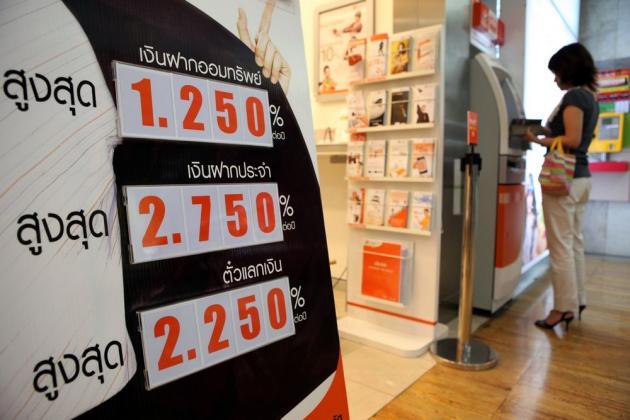HSBC expects BOT to hold off rate hikes

HSBC Global Research expects the Bank of Thailand's Monetary Policy Committee (MPC) to hold off a rate hike at tomorrow's meeting.
"Based on our current growth forecast of 5.5 per cent, inflation looks set to average 3.4 per cent this year. Should the data start to confirm our view of downside growth risks in the coming months, however, both our growth and inflation forecasts could see downward adjustments, with BOT potentially holding off (upward) interest rate hikes until early 2013. Next year, we expect GDP growth of 4.5 per cent and inflation of 3.8 per cent," it said.
While expecting the policy rate to remain at this level until early 2013, it also foresees some risk factors including the euro zone crisis as well as heightened political conflict which could dent export and domestic demand, respectively.
The following are the full version from the research.
The BOT is likely to keep rates on hold when it meets on Wednesday. Inflation has been slowing in y-o-y terms, for both headline and core, with the latter remaining within the
central bank’s 0.5-3.0 per cent target. The sequential momentum for both remains relatively stable (seasonally adjusted). Then there is the external outlook, which has wilted
somewhat since the MPC last met on 2 May.
Despite a likely no-change decision, it will probably continue to sound hawkish, after having witnessed the economy rebound by an unexpectedly strong 11 per cent q-o-q sa in Q1
2012 post floods. Based on this recovery, the MPC now expects 2012 growth of 6 per cent, up from 5.7 per cent earlier. It is wary of upside inflationary risks – strong demand conditions aside,
there is a risk that the government could lift various price controls. Inflation expectations could also be pushed up by a near-40 per cent hike in minimum wages in April, and heightened
public concern over the rising cost of living.
We believe the reasons for its hawkishness are entirely reasonable, and the rhetoric typical of its prudent style. However, the reality could pan out somewhat differently from the BOT
view. Its 6 per cent growth forecast looks ambitious. We are maintaining our forecast of 5.5 per cent for now and even this optimistically assumes (very strong) average sequential growth of 1.9 per cent qo-
q sa for the remainder of the year. Downside risks to the outlook are starting to creep in. Exports are beginning to succumb to the prevailing global economic cycle. Private
consumption and investment may already be “normalizing”. Political tensions are again also on the rise, which could potentially weigh on domestic demand and also tourism.
These factors suggest that inflation could take longer to climb than the BOT thinks.
Indeed, inflation expectations still seem pretty well anchored. Inflation looks set to average 3.4 per cent this year. Should the data start to confirm our view of downside growth
risks in the coming months, both our growth and inflation forecasts could see downward adjustments, with BOT then potentially holding off rate hikes until early 2013.
No reason to move yet
When the BOT monetary policy committee (MPC) meets this Wednesday, we believe there will be very little impetus for it to change monetary policy settings. For one, inflation in y-o-y terms has been slowing. Headline inflation in May printed 2.5 per cent, the same pace as April and a two and a-half month low. To an extent, government measures to delay the re-imposition of levies on certain fuels and keep in place the freeze on electricity tariffs, transport fares and basic household products has kept the price barometer low. Nevertheless, even after stripping out raw food and energy, core inflation has been slowing too, and remains firmly within the BOT’s target of 0.5-3 per cent – core prices rose 2 per cent y-o-y in May, the lowest print in 14 months.
External developments will also stay BOT’s hand. When the MPC last met on 2 May, it was still sounding reasonably upbeat on the external outlook, saying that the global economy had “continued to grow at a gradual pace with improving signs of recovery in the major economies.” Developments since then are likely to shake this view somewhat. Europe’s structural problems remain unresolved, and this weekend’s election in Greece brings with it the risk of significant global financial market volatility. In the US – where the BOT previously described the outlook as having “improved on the back of positive developments in the labour market and income prospects…” – concerns over the job market and broader recovery continue to linger, to the degree that policymakers are again talking about further policy accommodation.
Asia is probably the only region where conditions have not yet deviated significantly below the MPC’s assumptions, with economic growth there continuing to moderate in line with exports as the committee had stated previously. Moreover, while economic activity in China has been softer than expected in recent months, more aggressive monetary and fiscal stimulus is expected to help engineer a soft landing.
Maintaining a hawkish tone
We believe the MPC will not move on interest rates, but it will continue to sound hawkish. A primary reason is the unexpected strength of the rebound in the first quarter, following the floods of August-November 2011. The economy expanded 11 per cent q-o-q sa, or over 52 per cent on an annualized basis. Compared to a year ago, GDP was up 0.3 per cent. The sharp sequential bounce nearly lifted real output levels back tothose seen in Q3 2011, before the floods became more severe. In terms of output, most industries enjoyed a sharp rebound as clean-up efforts helped to restore the squeeze on supply. Notably, output from manufacturing – the hardest-hit industry during the floods – leapt 22.5 per cent q-o-q sa, accounting for 7.8 per cent-pts of the rebound. As workers returned to their jobs and companies ploughed capital into new plant and equipment, expenditure also came steaming back – domestic demand alone accounted for nearly two-thirds of the rise in GDP.
The MPC probably had a sense of these numbers, even though it had met nearly three weeks prior to the GDP release. Minutes of the 2 May meeting revealed that the committee had lifted its 2012 growth forecast to 6 per cent from 5.7 per cent in the previous meeting, “in light of the broad-based recovery.” Against this backdrop, the central bank has been wary of upside inflationary risks. As it noted in the May statement, items like electricity tariffs and public transportation fares may be adjusted upwards. Furthermore, “elevated oil prices and the minimum wage hike in the context of a strong pickup in domestic demand, as well as heightened public concern over the rising cost of living, could add to higher inflation expectations.”
Prudence versus reality
The factors cited by the BOT for its hawkish stance are entirely reasonable, in our view, and typical of its laudably prudent style. However we believe there are risks that the reality may pan out somewhat differently, where neither growth nor inflation climb towards the top-side as it so fears. For one, we believe its 6 per cent forecast for growth looks ambitious. We are maintaining our growth projection of 5.5 per cent, and even this optimistically assumes average sequential growth of 1.9 per cent q-o-q sa for the remainder of the year. This compares to a long-term potential growth rate of around 0.6 per cent q-o-q sa. Arithmetic aside, we believe downside risks to the outlook are starting to creep in. As discussed earlier, external headwinds continue to persist and risks to the global economic outlook remain tilted to the downside.
Admittedly, exports did stage a sharp V-shaped recovery post floods, rising a total of over 32 per cent between November and February (seasonally adjusted). Since then, however, the prevailing global cycle seems to have taken hold and the export trend appears to have softened again – as of April, exports were down over 6.5 per cent from February. This suggests that much the rebound we have seen in the export/manufacturing sectors is ‘technical’, i.e. attributable to the resurrection of supply-side constraints, rather than in response to strong demand.
Even the strength in domestic demand may prove difficult to sustain, with early signs of ‘normalization’ already appearing. Following a sharp post-flood recovery, the BOT’s private consumption index, an aggregate of 10 key consumption indicators such as passenger car and motorcycle sales, dipped in March and again in April. This was despite two very supportive developments coming into play – the start of the decline in crude oil prices, and a near-40 per cent hike in minimum wages across the Kingdom. It is possible that these factors could take some time to percolate before having any noticeable impact on spending patterns, but the dip in the consumer confidence index for May is not encouraging either in this regard.
Investment indicators are a bit more mixed. The BOT’s private investment index continued to soar in April, albeit primarily on the back of a surge in domestic machinery sales. Its sentiment index, however, shows some weakening in April, though respondents’ expectations for the next three months continue to remain buoyant. More broadly, we note that the BOT’s leading economic index – an indicator that has in the past led actual GDP growth by as much as two quarters – also took a breather in April.
As we assess the risks further out, it also worth highlighting that political tensions are once again on the rise. As we have seen in the past, this can have a debilitating effect not only on domestic demand, but also on tourism, which has managed to recover to pre-flood levels. The controversy arises from bills on a charter amendment and reconciliation that the ruling Pheu Thai party is trying to push through parliament.
The opposition and its supporters view the bills as an attempt to overthrow the monarchy and pave the way for fugitive former prime minister Thaksin to return with amnesty. In late May, the anti-Thaksin, pro-royalist “yellow shirts” held a three-day protest; though small, the protest was disruptive enough that parliament had to be postponed.
At the time of writing, the situation remains charged – according to the Bangkok Post, Pheu Thai is intending to defy an order from the Constitutional Court that parliament await a third (and final) reading of the charter amendment bill, as it reviews whether the charter amendments would be unconstitutional ornot. Pro-Thaksin “red shirts” have also staged protests, and are now calling for the removal of the Constitutional Court judges who intervened.
Against the above macro and political backdrop, inflation could take longer to climb to discomfiting levels than the BOT thinks. Should economic momentum normalize faster than expected, rather than remain above potential as is currently the case, then underlying demand-pull pressures on inflation may not be as intense as the BOT believes. Furthermore, the ending of various price controls may not occur that soon. Although this would translate into a wider fiscal deficit of 3.4 per cent of GDP, neither policymakers nor markets are likely to find this punitively large. Given the political landscape, we believe the political will to wind back some of these price controls may also be weak.
To this end, we note that inflation expectations still seem pretty well anchored. Although price expectations 12 months ahead (as measured by the BOT) did tick slightly higher in the first quarter
alongside the post-flood recovery in economic activity, by and large expectations have been gradually cooling since mid-2011. As of April, median expectations were for a y-o-y inflation reading of 3.5 per cent in the 12 months ahead, down from a 3.7 per cent print in March. Furthermore, pressures do not appear to be building in the pipeline – producer prices were up just 1.2 per cent y-o-y in May, after having trended lower for over two years.
Based on our current growth forecast of 5.5 per cent, inflation looks set to average 3.4 per cent this year. Should the data start to confirm our view of downside growth risks in the coming months, however, both our growth and inflation forecasts could see downward adjustments, with BOT potentially holding off (upward) interest rate hikes until early 2013. Next year, we expect GDP growth of 4.5 per cent and inflation of 3.8 per cent.





